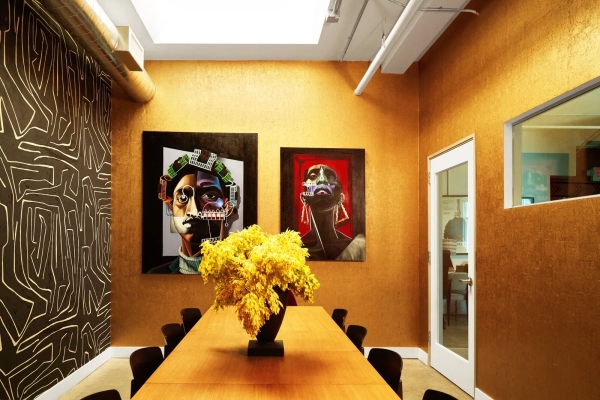Nearly every material has undergone a greenwashing campaign by this point. There are even versions of plastic that are now branded as “sustainable.” But lately, designers are embracing one surface that really does seem like the real deal: cork. Made from the outer bark of the cork oak tree, which can grow in Mediterranean climates for up to 200 years, the material is hand-harvested every nine years without harming the tree.
“It’s a rapidly renewable material and a powerful carbon sink,” explains Chelsea Minola, who runs the Washington-based studio Grain with her husband, James. “Due to the regeneration process, the more bark harvested from the tree, the more carbon is absorbed.”
Theirs was one of several cork-forward collections that we clocked this fall, as designers follow in the footsteps of pioneers like Tom Dixon, who has embraced the material in his furniture designs since 2017. Also in September, French designer Noé Duchaufour-Lawrance unveiled sculptural burnt cork furniture at Demisch Danant gallery in New York, and London-based designer Matilda Goad used the material to make lamps and urns with a classical twist. (“I wanted the material to be seen in a different, more elevated way,” she explains.) They’re all sourcing the material from Portugal, where nearly half of the globe’s cork is harvested.
The benefits of cork stretch far beyond its eco-friendliness: It’s hypoallergenic, moisture-and-fire-resistant, as well as sound- and heat-insulating. Marcel Proust famously lined his bedroom in the material to prevent pollen and dust from aggravating his allergies and asthma.
Soft yet durable, cork can be used both indoors and outdoors, and doesn’t need to be sealed with potentially harmful chemicals. “All of our work is solid cork, so if there is ever an issue with the surface, it can be easily refreshed with a light sanding,” Minola explains.
Unsurprisingly, interior designers have been embracing the staple for many of the same reasons, using it liberally on floors and walls. In a young couple’s London flat, Beata Heuman employed its sound-absorbing skills to use by cladding the walls of the home office. Charlap Hyman & Herrero used cork from Duro Design on the floors of an eclectic LA home, while a coffee-colored version was laid underfoot at a Louisiana retreat by Thad Hayes. And in Emma Chamberlain’s guest bath in LA, wall tiles by CorkHouse were applied to the walls to an enveloping extent.
“It’s durable, relatively inexpensive, sound-absorbing—a great alternative to wood that still has the warmth and natural feel,” says interior designer Jessica Ayromloo, who mixed it with graphic cement tiles on the floor of a colourful Mexico City apartment. She then carried the material into the kitchen, applying it to the faces of stainless steel cabinets. “The place wouldn’t have felt as cozy without the cork, especially since the owner didn’t want rugs in the living spaces,” Ayromloo says.
Depending on the application, cork can warm things up or lend a cool, industrial feeling. Take designer Miles Redd’s varied approaches: He’s applied it like tile, complete with corner squares, to lend a more formal look to a butler’s pantry in Ohio, and in an edgier take, he envelopes a Connecticut playroom in the material in an effort to tone down the room’s pitched roof. Even architect David Rockwell likes to dress up the material, adding metallic foil to inlaid cork for his wall covering collection for Maya Romanoff, dubbed Porto. “We took an organic and humble material and added a bit of drama and sparkle,” he shares.
Despite small boosts in popularity over the years—from early 20th-century designer Paul Frankl’s ardor of cork veneer to contemporary designers’ renewed interests—cork in interior and furniture design still seems like a relatively novel frontier. A material that feels almost futuristic, Minola says. “The idea that you harvest just what you need—not too much—and don’t disturb the ecosystem that surrounds it, is the way that we all need to be thinking about living in relationship with the natural world.”
_______________________________________________________________________________________________________________________________________________________
▪ Source: AD|https://www.architecturaldigest.in/story/designers-are-clamouring-for-cork-but-why/
▪ Words: Hannah Martin
▪ Photography Credit: ©Ben Blood, ©Christopher Sturman, ©Derry Moore, ©Laure Joliet, ©Joshua Kissi, ©Beata Heuman, ©Ryan Kurtz


